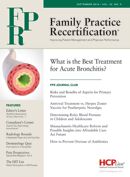Determining Risky Blood Pressure in Children and Adolescents
Determining if a child or adolescent has hypertension is complex and requires use of gender, age, and height specific readings. This study used a simplified approach of systolic and diastolic blood pressure readings compared to height as a screening tool for the diagnosis of hypertension in Chinese children.

Frank J. Domino, MD
Review
Xi, B., et al. “Determining Elevated Blood Pressure in Children and Adolescents.” Pediatrics 2014;134:e106-e111.
Determining if a child or adolescent has hypertension is complex and requires use of gender, age, and height specific readings. This study used a simplified approach of systolic and diastolic blood pressure readings compared to height as a screening tool for the diagnosis of hypertension in Chinese children.
Study Methods
This study was conducted in China using a health and nutrition survey of over 11,000 children aged 6 — 17 years. They followed age, gender, height, and blood pressure values and then compared ratios of systolic and diastolic blood pressures to height to determine if they could identify who was at greatest risk for hypertension.
Blood pressure was measured after the child or adolescent sat for 5 minutes. Three blood pressure values were obtained at the first visit. Height was measured using centimeters. Blood pressure screening ratios were identified as systolic blood pressure divided by height and diastolic blood pressure divided by height. The authors used the US National High Blood Pressure Education Working Group’s definition for hypertension as systolic blood pressure ÷ diastolic blood pressure ≥ the 95th percentile or higher.
Results & Outcomes
Results and Outcomes:
Of the 11,661 children included in this study the prevalence of hypertension was found to be 4.4%. The Table below demonstrates the ratio above which correlates with hypertension in the given age group.
6-11 years
12-17 years
SBP(mmHg) / Ht (cm)
0.84
0.78
DBP(mmHg) / Ht (cm)
0.55
0.50
Conclusion
Blood pressure to height ratio is an effective hypertension screening tool between the ages of 6 and 17 years among Chinese children.
Commentary
With the advent of obesity and a more sedentary lifestyle, the diagnosis of hypertension in children and adolescents is becoming far more common. An adult lifetime complicated by hypertension would imply a significantly increased risk of premature heart disease, blindness, renal failure, and all of the other complications of small vessel disease.
Identifying those at risk for hypertension and standard blood pressure measurement of children is a complicated issue. First, you need to have an accurate measurement of the blood pressure.
Most blood pressure cuffs are standardized towards adults, not children. Additionally you need a protocol to interpret their blood pressure readings when compared to gender, height, weight, etc. This makes the process of identifying who is at risk for hypertension cumbersome and often neglected.
This study reports a very simple and effective method to identify children and adolescents who may be at risk for hypertension. Unfortunately, this study was done in Chinese children, so it cannot be immediately generalized in those of other nationality or ethnicity.
Using the BP to height ratios provided a very high negative predictive value (≥ 99%). This means when the ratio was less than the cut-offs identified, there was very little chance the child in question had hypertension. The positive predictive values were considerably lower ranging from 13% - 75%. This means that a blood pressure reading to height ratio above the identified threshold screened positive for hypertension, but further testing was warranted to actually make the diagnosis. In other words, false negatives were very uncommon, while false positives were more common and should prompt further investigation.
Until this study is repeated in the west, its use as a sole screening method to determine who is at risk for hypertension can not be recommended. But using these ratios today as one piece of information to consider further testing should be considered. Additionally, this study should be repeated in all other countries where pediatric hypertension, obesity, and sedentary lifestyle have become very common.
About the Author
Frank J. Domino, MD, is Professor and Pre-Doctoral Education Director for the Department of Family Medicine and Community Health at the University of Massachusetts Medical School in Worcester, MA. Domino is Editor-in-Chief of the 5-Minute Clinical Consult series (Lippincott Williams & Wilkins).
Additionally, he is Co-Author and Editor of the Epocrates LAB database, and author and editor to the MedPearls smartphone app. He presents nationally for the American Academy of Family Medicine and serves as the Family Physician Representative to the Harvard Medical School’s Continuing Education Committee.
